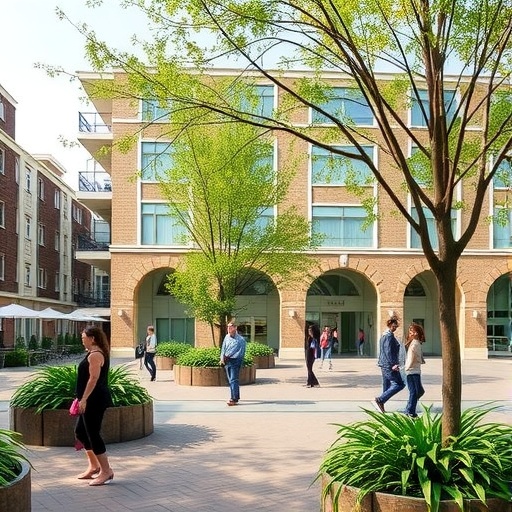In the rapidly urbanizing world, green spaces have emerged as vital sanctuaries that offer not only environmental benefits but also social and psychological advantages to city dwellers. However, the design and consultation processes involved in creating these urban green areas have long been plagued by a fundamental challenge: accommodating the diverse and often conflicting public needs and preferences. A groundbreaking study by Nguyen, Collins, and Collins, published in npj Urban Sustainability, presents an innovative framework aimed at comprehensively understanding public pluralities in greenspace design and consultation, potentially revolutionizing the way urban planners engage with communities.
Traditional approaches to urban green space development have tended to rely on generalized assumptions about public preferences, often implementing designs that cater to a singular or dominant vision of what a park or greenspace should represent. This oversimplification neglects the pluralistic nature of urban populations, where varied cultural backgrounds, socio-economic statuses, age groups, and lifestyles influence how individuals perceive and interact with green spaces. The framework introduced by Nguyen et al. directly addresses this complexity by proposing a model that explicitly recognizes and integrates multiple public perspectives during both the design and consultation phases of greenspace projects.
At the core of this framework lies an acknowledgement that urban constituents are not a homogenous body but rather a constellation of distinctive groups, each possessing unique narratives and expectations about greenspace usage. By leveraging advanced participatory methodologies and analytical models, the study elucidates mechanisms through which planners can capture nuanced opinions and desires in a structured yet flexible manner. This approach facilitates the identification of overlapping interests as well as irreconcilable points, enabling informed trade-offs and adaptive design solutions that resonate authentically with the community.
One of the technical strengths of the framework is its integration of sociological and spatial data analytics. It employs a mixed-methods strategy combining qualitative inputs—such as focus groups and ethnographic observations—with quantitative metrics derived from survey instruments and geospatial analysis. This dual data stream allows stakeholders to visualize and map the geographical distribution of plural public demands, highlighting contextual variables such as neighborhood demographics, existing infrastructure, and accessibility patterns that critically influence greenspace interactions.
Moreover, the framework incorporates iterative feedback loops whereby initial greenspace design proposals are presented back to varied public constituencies for evaluation and refinement. This cyclical engagement process is supported by digital platforms that enhance transparency and broaden participation, thereby democratizing the decision-making environment. By fostering continuous dialogue between planners and publics, the framework mitigates the risks of top-down imposition and empowers marginalized voices often excluded from urban planning discourse.
The implications of adopting Nguyen and colleagues’ framework extend far beyond immediate urban parks or gardens. Cities worldwide face mounting pressures from climate change, social inequity, and population growth, all of which underscore the critical need for inclusive, resilient, and multifunctional greenspaces. Applying a pluralistic consultation lens equips urban stakeholders to craft designs that not only accommodate ecological functions but also promote social cohesion, cultural expression, and mental well-being across diverse communities.
Technically, the study advances the field of urban sustainability by offering a replicable model adaptable to varying sociopolitical contexts and scales. It outlines protocols for stakeholder identification, stratification of public pluralities, and scenario modeling that simulate the outcomes of different design choices on community satisfaction indices. These tools enable planners to anticipate conflicts and synergies in public preferences, stimulating more strategic and evidence-based urban greenspace governance.
The research also challenges practitioners to reconsider entrenched hierarchies of expertise. By positioning community insights as central data points rather than ancillary anecdotes, the framework rebalances power dynamics traditionally skewed toward technocratic control. This democratization carries potential ripple effects for broader urban policy-making, encouraging more just and equitable urban environments where citizens co-produce their living landscapes.
Importantly, the authors highlight technological innovations as instrumental in operationalizing their framework. Geographic Information Systems (GIS), machine learning algorithms for pattern recognition, and online participatory mapping tools coalesce to create dynamic feedback systems. These technologies not only streamline data collection and analysis but also enhance user engagement by providing intuitive visualization and scenario exploration capabilities.
Critically, the framework emphasizes the temporal dimension of greenspace planning. Urban environments and their social fabrics are in constant flux, necessitating designs that can evolve responsively. The authors advocate for flexible design guidelines and policy instruments capable of accommodating shifting public needs and environmental conditions over time, thus ensuring longevity and relevance of greenspaces for future generations.
The study’s interdisciplinary approach, bridging urban planning, sociology, computer science, and environmental psychology, exemplifies the kind of cross-sector collaboration essential for tackling complex urban challenges. By synthesizing diverse disciplinary insights, Nguyen et al.’s framework offers a holistic method that captures the multifaceted nature of urban green space dynamics.
As urban populations continue to swell, the urgency of creating inclusive and sustainable greenspaces will only intensify. This study provides a timely and powerful contribution, urging municipalities and planners to move beyond simplistic public engagement toward an empirical, pluralistic, and iterative process that genuinely accounts for the variegated urban publics they serve.
In conclusion, the framework advanced by Nguyen, Collins, and Collins marks a significant advancement in urban sustainability scholarship and practice. It not only deepens theoretical understanding of public pluralities but also delivers practical tools that can transform greenspace design paradigms worldwide. By embedding complexity, inclusivity, and adaptability at the heart of urban greenspace planning, this work paves the way for greener, fairer, and more vibrant cities.
Article References:
Nguyen, N.T., Collins, A.M. & Collins, C.M. Framework for understanding public pluralities in greenspace design and consultation. npj Urban Sustain 5, 56 (2025). https://doi.org/10.1038/s42949-025-00244-6
Image Credits: AI Generated




